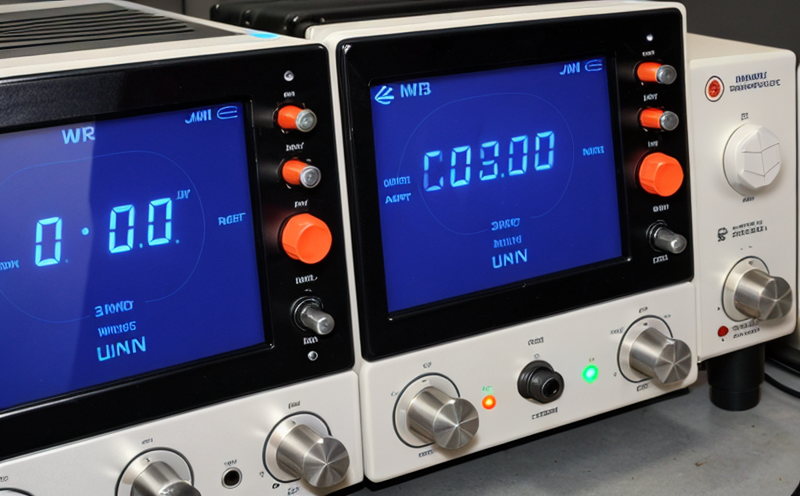UL 62368 Wireless ICT Equipment RF Safety Compliance Testing
The UL 62368 standard is a comprehensive set of requirements designed to ensure the safety and functionality of information and communication technology (ICT) equipment. Within this framework, Wireless Communication & RF Testing specifically addresses the electromagnetic compatibility (EMC) aspects of devices that operate in wireless environments. This service focuses on ensuring compliance with UL 62368-10, which deals with radio frequency (RF) safety.
The standard covers a wide range of ICT devices, including smartphones, tablets, routers, and other connected devices that emit or are exposed to RF energy. The objective is to prevent potential hazards from RF radiation, such as burns or interference with medical devices. To achieve this, the testing process involves several critical stages:
- Field Strength Measurements: This involves measuring the electromagnetic fields generated by the device in various operational modes.
- Thermal Analysis: Ensuring that the device does not overheat due to RF exposure.
- Interference Testing: Evaluating whether the device causes or is affected by interference from other devices in its environment.
- Compliance with Limits: Verifying that the device operates within the established limits for RF emissions and susceptibility.
The testing process is rigorous, employing advanced instrumentation such as spectrum analyzers and field strength meters. Specimen preparation involves simulating real-world usage scenarios to ensure that the device performs safely under all conditions. Reporting standards are strictly adhered to, ensuring that the results can be relied upon for regulatory compliance.
UL 62368 Wireless ICT Equipment RF Safety Compliance Testing is essential for manufacturers and suppliers who wish to meet international safety standards and avoid product recalls or market bans. By ensuring compliance with this standard, businesses can enhance their reputation and trust in the marketplace while protecting consumers from potential hazards.
Why It Matters
The importance of RF safety cannot be overstated, especially in an era where wireless technology is pervasive. Compliance with UL 62368-10 ensures that ICT devices are safe for consumers and do not pose risks to their health or well-being. By adhering to this standard, manufacturers can:
- Protect users from potential injuries caused by RF radiation.
- Avoid legal issues and product recalls due to non-compliance.
- Enhance brand reputation and consumer trust.
- Ensure seamless interoperability with other wireless devices in the market.
The standard also helps manufacturers stay ahead of regulatory changes, ensuring they are prepared for future requirements. By investing in compliance testing early in the product development process, companies can streamline their certification efforts and reduce costs associated with late-stage modifications.
In addition to consumer safety, compliance with UL 62368-10 also supports broader industry goals such as reducing electromagnetic interference (EMI) and promoting a more resilient wireless ecosystem. This is particularly important in sectors like healthcare, where the potential for interference with medical devices could have serious consequences.
Industry Applications
| Industry Sector | Device Type | Testing Focus |
|---|---|---|
| Consumer Electronics | Smartphones, Tablets | Field strength measurements, thermal analysis. |
| Networking | Routers, Access Points | Interference testing, compliance with limits. |
| Medical Devices | Portable medical devices | Thermal analysis, interference testing. |
| Automotive | In-Vehicle Infotainment Systems | Field strength measurements, compliance with limits. |
| Smart Home | IoT Devices | Interference testing, thermal analysis. |
The UL 62368-10 standard is particularly relevant for industries where wireless communication plays a crucial role. Consumer electronics, networking devices, and medical devices are among the sectors that benefit most from this testing. By ensuring RF safety in these applications, manufacturers can enhance user experience while minimizing risks.
Use Cases and Application Examples
The application of UL 62368 Wireless ICT Equipment RF Safety Compliance Testing is wide-ranging, encompassing various use cases across different sectors. Here are some examples:
- Smartphones: Ensuring that the device does not emit excessive RF energy and that it can function safely in environments with other wireless devices.
- Routers: Testing for interference in densely populated areas where multiple devices operate simultaneously.
- Pacemakers: Evaluating whether a new smartphone model could potentially interfere with medical devices.
- In-Vehicle Infotainment Systems: Checking that the system does not emit harmful RF signals and is safe for use in vehicles.
- Smart Home Devices: Ensuring that IoT devices operate safely without causing interference to other connected devices.
In each of these cases, the testing process involves a series of steps designed to simulate real-world conditions. This ensures that the device performs safely and reliably in all operational scenarios.
The results of this testing are crucial for regulatory bodies such as the FCC (Federal Communications Commission) and the CE marking scheme. Compliance with UL 62368-10 is often a prerequisite for these certifications, making it an essential part of the product development process.





